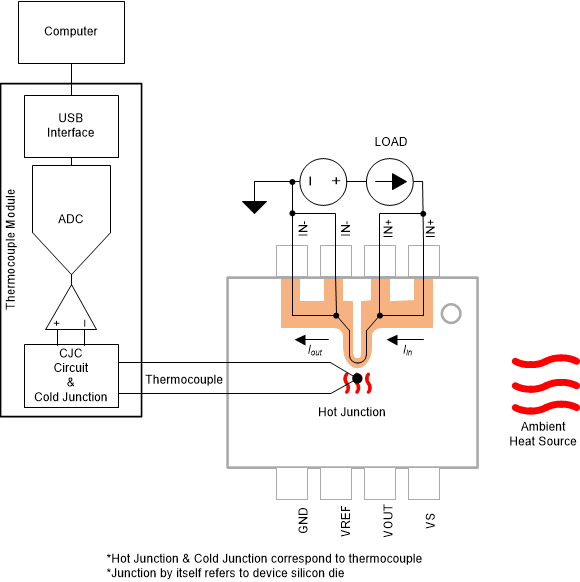SBOA400 July 2020 – MONTH TMCS1100 , TMCS1100-Q1 , TMCS1101 , TMCS1101-Q1 , TMCS1107 , TMCS1107-Q1 , TMCS1108 , TMCS1108-Q1
5 Measuring Case Temperature
One common method used for approximating junction temperature is the case temperature. While the case temperature provides information that can be used to determine the junction temperature, its temperature value is not equal to the junction temperature. All convective and conductive heat equation variables will have some impact on how close the case temperature is to the junction temperature. For this application report multiple points were taken to derive the relationship. While such granularity may not be possible for your setup, we believe you need at least two current load points per ambient temperature condition to confidently relate case temperature to junction temperature.
Figure 5-1 illustrates one possible test setup for measuring case temperature. For this application report the case top was chosen as the surface for the case thermocouple as it readily accessible on the EVM layout. In particular, the probe was positioned on the top such that the thermocouple hot joint was roughly positioned over the bend in the leadframe, and thereby the shortest distance from the primary origin of heat in the device. This was held in place by the fixture shown in Figure 2-5 and the thermal connection was enhanced with thermal paste.
Step Summary
- Choose a well characterized temperature sensor, such as a thermocouple with thin leads.
- Use thermal paste to ensure good thermal connection between TMCS1100 and temperature sensor.
- Secure temperature sensor with non-conductive, thermally robust fixture that provides repeatable placement.
- Sweep DUT through series of load current levels. At minimum measure two current levels.
 Figure 5-1 Case Measurement Schematic
Figure 5-1 Case Measurement Schematic